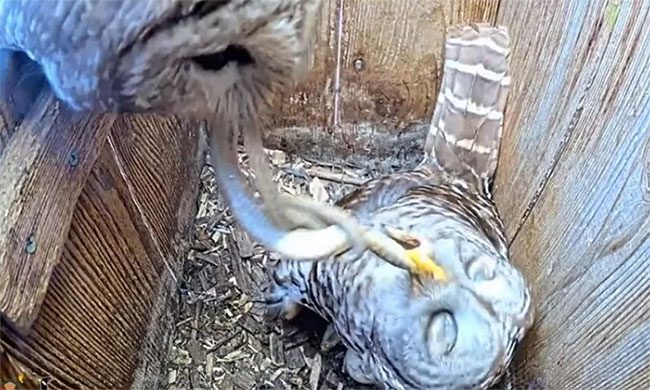Camera footage from the nest shows the male owl effortlessly swallowing a large striped snake, as if it were a strand of spaghetti.
The feeding behavior of the striped owls was captured by a remote-controlled camera set up by the laboratory at Cornell University, located in New York, as reported by Newsweek on April 17. According to researchers’ posts on Facebook, the male owl greeted its mate with a substantial meal near the entrance of the nest. This was the first snake the male brought back to the nest this season, showcasing the diverse prey that striped owls typically hunt.
The female owl consumes the striped snake. (Video: Bird Cam).
The specially designed box nest was constructed in 1998 by Jim Carpenter, founder and CEO of Wild Birds Unlimited, in his backyard. The first time birds occupied the box was in 2003. Since then, striped owls have returned to nest almost every year. The nest camera is part of the Bird Cam network of the Cornell Lab of Ornithology. The team of experts at the university aims to preserve biodiversity on Earth through scientific research and education, focusing on bird species.
According to Ben Walters, a communication specialist at the lab, the male striped owl takes on the responsibility of providing food for the mate during the incubation period (28 – 33 days), while the female cares for the eggs. After the eggs hatch, the male continues to hunt for the female and the chicks for about two weeks. At that point, the chicks will have grown large enough to remain in the nest alone, allowing the female to return to hunting.

Striped owls are opportunistic predators, meaning their prey is incredibly diverse. They hunt and consume anything they can capture. Their diet includes small animals such as squirrels, chipmunks, mice, voles, rabbits, birds, amphibians, reptiles, and invertebrates. The snake in the video is likely a large striped snake. Striped owls typically swallow small prey whole, including snakes, while for larger prey, they tear it into pieces before swallowing.
Striped owls mate for life and raise one brood each year. The chicks grow rapidly, gaining approximately 14 grams per day during their first month. Young owls will leave the nest at 4 to 5 weeks of age. At this stage, they weigh about 50-75% of an adult and are not proficient fliers. Instead of flying, they tend to drop to the ground or hop from branch to branch. Young owls begin to fly short distances around 10 weeks of age. Adult owls continue to care for the young for several months until they are ready to disperse and find their own territory.


















































